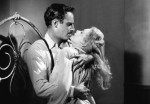Orson Welles’ “Touch of Evil” opens with an explosion of sight and sound: the loud jazz of jukeboxes, honking cars and near the scene’s conclusion, a literal explosion – a car goes up in flames after a bomb detonates.
Welles sets the location in a long three-minute tracking shot that has since become legendary. We, as an audience, are transported to a U.S-Mexico border town that sits at the edge of a precipice – a place engulfed by murder, rape, corruption and drugs.
This Saturday, the film will be showing at the Million Dollar Theatre by Venice Beach, near the area where the opening sequence was filmed.
Lurid and sensational, “Touch of Evil” follows the head-to-head conflict between a Mexican officer, Mike Vargas (Charlton Heston), and a prejudiced, sadistic sheriff, Hank Quinlan (Welles). While the latter sets out to prove that a Mexican man was responsible for the car bomb that begins the film, Vargas believes Quinlan is planting evidence to incriminate innocent people.
After Vargas’ pretty American bride Susan (Janet Leigh) is kidnapped, injected with drugs and framed for murder, he must race against the clock to prove her innocence and figure out Quinlan’s agenda.
With rich and vibrant black-and-white cinematography that lends the film its visual seediness, “Touch of Evil” is a quintessential noir classic. It is both aesthetically and narratively darker than almost any film that emerged from the movement. Though most of the movies were preoccupied with the bleakness of humanity, “Touch of Evil” in particular is especially pessimistic. Marlene Dietrich, playing a gypsy fortune teller, delivers one of the noir’s most foreboding utterances after Quinlan asks her to read his fortune. “You haven’t got any,” she says. “Your future’s all used up.”
Much has been said about the towering tour de force of Welles, the early prodigy, who, by 26, had started one of the most popular radio programs of the 1930s, “The Mercury Theatre on the Air,” and made the long touted masterpiece of American cinema “Citizen Kane.”
However, his later works tend to be ignored by the public at large, brushed off as films that never quite reached the heights of “Citizen Kane.” I’m troubled by this assessment. “Touch of Evil,” in my mind, is just as daring, inventive and masterful as “Citizen Kane,” and symbolizes film noir’s final, brilliant breath.
“Touch of Evil” also, however, symbolizes Welles’ final fall from grace in Hollywood. In post-production, the film was taken from him, butchered and edited without his consent. Scenes were re-shot by a different director, and it became a completely different film than Welles initially intended.
When it was finally released, “Touch of Evil” was the B picture on a double bill, following an unmemorable melodrama with Hedy Lamarr called “The Female Animal.” Welles would never truly work as a director in the dream factory of Hollywood ever again.
In recent decades, however, “Touch of Evil” has been elevated to the status of a cult film. In the late ‘90s, it was restored as closely as possible to Welles’ original vision. In this now widely circulated version, the film and its filmmaker have been vindicated. It is finally the film it was meant to be, in all its dark and disturbing glory.
What classics films would you like to see receive their time in the limelight? Email Colvin at icolvin@media.ucla.edu.

Mr. Colvin,
Very nice to read your high regard of TOUCH OF EVIL (even the Uni-hacked version…), but you might want to look at a map so your readers can plan their Venice-to-Downtown Los Angeles commute…
The Million Dollar Theatre (https://sites.google.com/site/downtownlosangelestheatres/million_dollar) is nowhere nearer to the many TOUCH OF EVIL filming locations in Venice (http://www.yovenice.com/2013/01/31/vintage-los-angeles-touch-of-evil/) than the Hollywood sign.
Those interested in revisiting EVIL — better yet: seeing it for the first time — can find out more about Vintage Los Angeles’ Noir series here: https://www.facebook.com/events/1394474647498751/
As for the “butchering,” I’m not quite sure why the studio’s tinkering with EVIL gets such attention (http://wellesnet.com/touch_memo1.htm), as if recuts or reshoots were (or are) rarities.
By this point in his career, Welles was no stranger to meddling. Look at the clumsily tacked on scenes in THE MAGNIFICENT AMBERSONS (http://mtatthemovies.blogspot.com/2009/11/decline-fall-of-magnificent-ambersons.html).